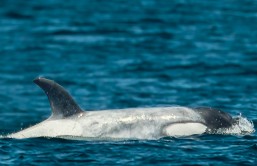A new 250 million-year-old fossil reptile was recently unearthed by an international team of paleontologists from Brazil and the U.K. It is believed that this specimen marks an incredible discovery, as it is a predecessor of dinosaurs and therefore helps fill in missing evolutionary gaps.
A nearly complete and remarkably preserved skull of this new reptile species was discovered by the team in the state of Rio Grande do Sul in southernmost Brazil. Researchers have dubbed the specimen Teyujagua paradoxa, meaning "fierce lizard."
Dating the fossils revealed the ancient creature emerged just after the great Permo-Triassic mass extinction event that occurred 252 million years ago. This event was likely triggered by massive, intense volcanic eruptions that wiped out 90 percent of all living species.
Following the volcanic activity, ecosystems on land were sparsely populated, which means those species that did survive the mass extinction were able to diversify and expand in population. Therefore, the discovery of Teyujagua sheds new light on how the Earth recovered following the extinction and clarifies the initial evolution of the group of animals that eventually gave rise to dinosaurs, pterosaurs - flying reptiles - crocodiles and birds.
"The discovery of Teyujagua was really exciting. Ever since we saw that beautiful skull for the first time in the field, still mostly covered by rock, we knew we had something extraordinary in our hands," said Felipe Pinheiro, one of the study researchers from the Universidade Federal do Pampa in Rio Grande do Sul. "Back in the lab, after slowly exposing the bones, the fossil exceeded our expectations. It had a combination of features never seen before, indicating the unique position of Teyujagua in the evolutionary tree of an important group of vertebrates."
With its quadrupedal gait, small body measuring only 1.5 meters in length, sharp carnivorous teeth and nostrils resembling those of modern-day crocodiles, Teyujagua is very different from other fossils of the same age. Researchers say its anatomy is intermediate between more primitive reptiles and a group called archosauriforms, which includes all extinct dinosaurs and pterosaurs, along with modern day birds and crocodiles.
"Teyujagua is a really important discovery because it helps us understand the origins of a group of vertebrates called archosauriforms. Archosauriforms are spectacularly diverse and include everything from hummingbirds and crocodiles to giant dinosaurs like Tyrannosaurus rex and Brachiosaurus," explained Richard Butler, one of the study researchers from the University of Birmingham's School of Geography, Earth and Environmental Sciences. "Teyujagua fills an evolutionary gap between archosauriforms and more primitive reptiles and helps us understand how the archosauriform skull first evolved."
Teyujagua is believed to have lived in lakes and rivers, hunting amphibians and procolophonids - extinct, small-bodied reptiles similar to modern-day lizards. Following the Permo-Triassic mass extinction, archosauriforms and their close kin, such as Teyujagua, likely rose as the dominant animals, paving the way for the emergence of dinosaurs.
Excavations at the site where this ancient reptile was found are still ongoing. Researchers hope to unearth more fossil remains that will help them piece together Earth's ancient history.
Their findings were recently published in the journal Scientific Reports.








